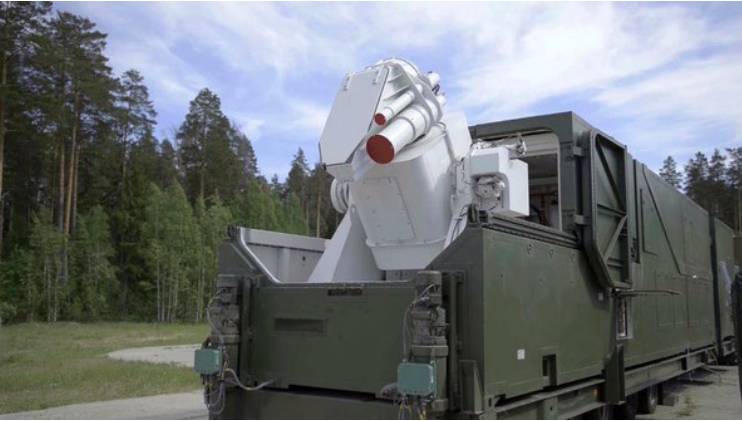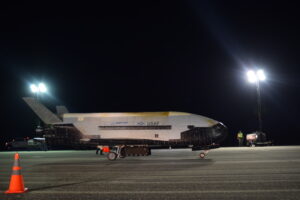
A Russian mobile laser system used to dazzle aerial and space reconnaissance assets.
Image credit: Russian Ministry of Defense.
WASHINGTON: With regard to the potential for war in space, the COVID-19 pandemic has been the proverbial silver lining in the cloud — with two studies on the development of global anti-satellite weapons capabilities showing no Big Bangs happening in 2020.
Perhaps the biggest surprise in the fourth annual editions of the twin counterspace studies by the Secure World Foundation (SWF) and the Center for Strategic and International Security (CSIS) is just how little China’s military seems to have been up to over the past year. That’s especially intriguing given the widespread perception among US military commanders and in Congress that Beijing is seeking to ‘dominate’ not only near-Earth space where the US military is today predominant, but even the Moon and Mars.
That said, it doesn’t mean everything is now unicorns and rainbows in orbit. Russia, in particular, continued in 2020 to test and field capabilities that very clearly are aimed at attacking US satellites, both studies found. While Moscow didn’t demonstrate anything really new, it did just keep on keeping on with its robust efforts to find ways to undercut US military advantage in space.
“For me, the thing that stuck out was just how much stuff the Russians are doing,” Brian Weeden, SWF director of program planning, said in an email. “Not only are they continuing to expand and integrate very good electronic warfare capabilities into their conventional forces, there’s also strong evidence they have an active co-orbital ASAT program again.”
“Russia tested a co-orbital ASAT weapon in July 2020, and it tested a direct-ascent anti-satellite (ASAT) weapon in December 2020,” CSIS’s Space Threat Assessment 2021 bluntly asserts. “These activities are not new and reflect a pattern of behavior in which Russia has continued to develop and reconstitute its counterspace capabilities.”
Further, Weeden cautions, just because there is little information about Chinese counterspace activities available in open source literature — upon which both studies rely — it doesn’t necessarily mean that the PLA is doing nothing to improve its capabilities to attack satellites.
“From the evidence we have available, it sure looks like Russia is a bigger counterspace threat than China, which is contrary to a lot of the public discussion that focuses almost entirely on China,” he said. “The caveat is that there are things we just can’t observe well with open source data. It’s possible that China has more programs going on and they just haven’t moved to public testing yet, or that their focus is more on the cyber and directed energy capabilities that are harder to observe.”
The most interesting Chinese development that could be seen, both studies agree, was its launch and recovery of an experimental spaceplane similar to the United States’ X-37B spaceplane, using a Long March 2F rocket. The spaceplane, in turn, apparently launched a couple of small satellites into Low Earth Orbit (LEO).
SWF Foundation’s report, Global Counterspace Capabilities 2021, explains:
“On September 4, 2020, China launched what it called a “reusable experimental spacecraft into orbit on a CZ-2F rocket from Jiuquan Satellite Launch Center under unusually heavy secrecy. Few facts are known, but the U.S. military cataloged the spaceplane … in a 348 km by 331 km and 50.2° inclination orbit. One day later, they cataloged three pieces of debris in a similar orbit and the following day, on September 6, the U.S. military cataloged an unknown payload in orbit (Object A, 2020-063G, 46395) while also indicating the spaceplane had re-entered the atmosphere. Outside experts suggested that the spaceplane could have landed on a long runway constructed at China’s Lop Nor nuclear test site. The mission of the small satellite it deployed is unknown.”
However, even CSIS — which looks at counterspace capabilities through a US threat lens — says that the Chinese spaceplane probably doesn’t have an ASAT mission. “Experts, however, are uncertain of the motivations behind or mission of this new space plane, but it is unlikely to be used as a counterspace weapon,” the study says.

X-37B space plane
And speaking of military spaceplanes, among the avalanche of military space activities undertaken by the US in 2020 under the Trump administration, SWF notes that DoD: “Clarified that the operation of the X-37B is now overseen by Space Delta 9 of the U.S. Space Force, which conducts warfighting activities in space.”
The move just adds to long-standing belief abroad (even among many allies) that the X-37B Orbital Test Vehicle itself is space weapons platform, says Victoria Samson, head of SWF’s Washington office. This is despite the fact that its small payload bay makes that unlikely (although some experts suspect it might at max be capable of jamming). The US has long said that the spaceplane’s primary mission is testing novel sensors and such on orbit. But the program’s new home “doesn’t help concerns about the X-37B’s raison d’etre,” Samson said in an email.
Samson said that among “the less flashy parts” of the studies, there were two intriguing developments: the launch by the Islamic Revolutionary Guard Core (IRGC) of a military satellite; and North Korea’s “lack of, well, anything.”
She noted that “Iran’s space program has been malingering for a while now — it had been years since they had a successful satellite launch. That was with the Iranian Space Agency. Now the IRGC showed in April that it can launch a satellite. That is a shift, both in terms of who is launching their satellites and their success rate.”
SWF’s study details the launch:
“In April 2020, the IRGC launched from its Shahroud base a satellite (Noor-1) on a previously unknown SLV, the Qassed.674 This SLV used a combination of liquid and solid fuel based respectively on the Iranian Ghadr-110 medium range ballistic missile and Salman solid-fueled rocket engine, has three stages, and can be launched via a TEL. Noor-1 was described as a military reconnaissance satellite which appears to be a 6U cubesat; it was detected in a SSO at an altitude of 425 km.”
Regarding Pyongyang, Samson said “there was really nothing to report on new things” in 2020. “This doesn’t mean that they haven’t been up to stuff elsewhere — they’ve been very active in ballistic missile launches, for example. But it does show that space is not apparently a hugely important program for the DPRK government.”
Three reasons Russia dismissed Sergei Shoigu, its longtime defense minister
Andrei Belousov will be the third in a series of Russian Defense Ministers with no military experience and no background in national security matters.


























